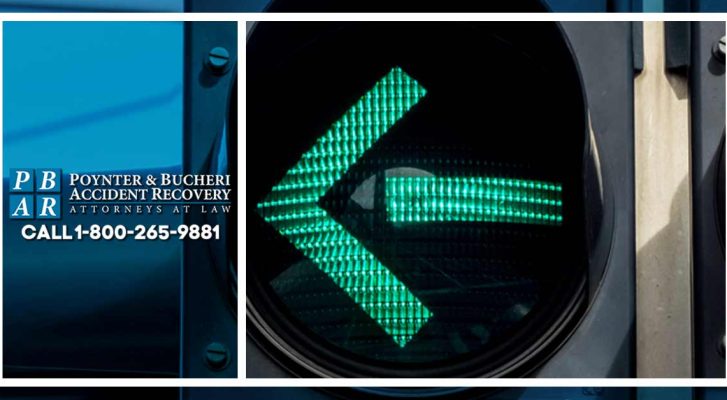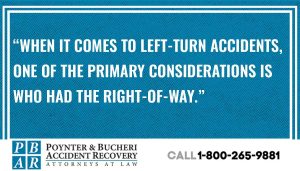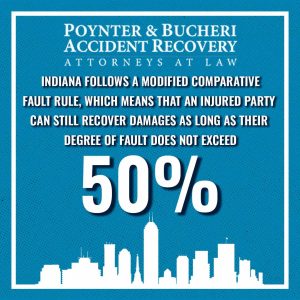
Who Is At Fault in a Left-Turn Accident?

Making left turns while driving may seem like second nature. But what happens when someone makes an unsafe left turn while you are traveling in the opposite direction? Or someone fails to stop at a stop sign and makes a left-hand turn directly into cross-traffic? Determining fault in left-turn accidents may seem straightforward at first glance – after all, common driving rules dictate that vehicles turning left must yield to oncoming traffic. However, this may not be the case. In fact, the fault is shared between drivers in some cases, or unforeseen circumstances shift the blame for the car accident away from the driver making the left turn.
At Poynter & Bucheri Accident Recovery, our experienced car accident attorneys understand the complexities involved in left-turn collisions. We know how to thoroughly investigate these accidents, gather evidence, and build strong cases to protect the rights of injured victims. In this blog, we’ll explore the various elements that influence fault determination in a left-turn accident case.
Right-of-Way Laws & Determining Fault in a Left-Turn Accident

When it comes to left-turn accidents, one of the primary considerations is who had the right-of-way. In most states, including Indiana, drivers turning left at an intersection must yield the right-of-way to oncoming traffic. This means that if a collision occurs between a left-turning vehicle and an oncoming car traveling straight, the presumption is often that the left-turn driver is at fault for failing to yield.
However, each car accident case is unique. There are certain situations where the oncoming traffic may be fully or partially responsible for the left-turn car accident, even with the other driver turning left. Let’s explore some of these scenarios:
Exceptions Where the Left-Turning Driver May Not Be At Fault
1. The Opposing Driver Was Speeding or Driving Recklessly
If the approaching driver was exceeding the posted speed limit or driving in an aggressive or reckless manner, they may be found partially or entirely at fault for the accident. In such cases, the left-hand turning driver may have misjudged how fast oncoming traffic was traveling, leading to the collision.
2. The Traveling Driver Ran a Red Light
If the oncoming driver disregarded a red light and entered the intersection without a green light, they would likely be held responsible for the accident, even if the other driver was making a left turn at the traffic light. Distracted driving frequently leads to this error. Drivers must obey traffic signals and traffic laws and yield the right-of-way to vehicles lawfully proceeding through an intersection.
3. The Opposing Driver Was Passing Illegally
If oncoming vehicles were attempting an illegal passing maneuver at the time of the collision, the driver making the left turn may not be held liable. Illegal passing can create unexpected situations that make it difficult for other drivers to react appropriately.
4. The Oncoming Drivers Took Sudden or Unexpected Action
In some cases, oncoming drivers may take sudden or unexpected evasive action, such as swerving or braking abruptly, making it impossible for the driver turning left to avoid a collision. If the left-turning driver had no reasonable way to anticipate such an action, the fault may lie with the oncoming drivers.
5. The Left-Turning Driver Had a Protected Green Arrow
If the driver turning left had a green arrow signal indicating that it was safe to proceed with the turn, they would generally have the right-of-way over oncoming traffic, unlike the common unprotected left turn. In this scenario, any oncoming vehicle that failed to yield would likely be held responsible for the accident.
Shared Fault and Comparative Negligence

In many left-turn accident cases, both drivers may share some degree of fault. This is where the concept of comparative negligence comes into play. Indiana follows a modified comparative fault rule, which means that an injured party can still recover damages as long as their degree of fault does not exceed 50%.
For example, if a left-hand driver failed to properly signal their intention to turn but the oncoming driver was also speeding when the accident occurred, both parties may be assigned a percentage of fault. If the left-turning driver is found to be 30% at fault and the oncoming driver 70% at fault, the left-turning driver can still recover personal injury damages, but their compensation will be reduced by their assigned percentage of fault (30% in this case).
Factors That Can Influence Fault Determination After Left-Hand Turn Collisions
While the actions of the drivers involved are often the primary focus in accident cases involving left-hand turns, there are other factors that can influence the determination of fault in a left-turn auto accident:
1. Road Conditions and Visibility: Poor weather conditions, such as rain, snow, or fog, can impair visibility and make it more difficult for drivers to judge distances and react appropriately. Similarly, obstructions like parked vehicles or foliage can block sightlines and contribute to accidents.
2. Mechanical Failures or Defects: In some cases, a mechanical failure or defect in one of the vehicles involved may have contributed to the accident. For example, if a car’s brakes failed or a tire blew out, causing the driver to lose control and enter the intersection, the manufacturer or a negligent mechanic could potentially be held liable.
3. Road Design and Traffic Control Devices: Poorly designed intersections, confusing traffic signals, or obstructed signage can create hazardous conditions that increase the risk of accidents. In such cases, the responsible government entity or contractor may share liability for the accident.
4. Distracted Driving: If either driver was distracted by a mobile device, GPS system, or other factors at the time of the accident, their inattention could contribute to a finding of fault.
5. Impaired Driving: Driving under the influence of alcohol, drugs, or certain medications can significantly impair a driver’s judgment, reaction time, and ability to operate a vehicle safely. If impairment played a role in the accident, the impaired driver would likely be held primarily or entirely at fault.
The Importance of Thorough Investigation and Evidence Collection After Left-Turn Accidents
Given the numerous factors that can influence fault determination in an accident case involving left-hand turns, it is crucial to conduct a thorough investigation and collect evidence.
This may include:
- Obtaining police reports and witness statements
- Securing surveillance or dashcam footage of the accident
- Photographing the accident scene, including skid marks, debris fields, and road conditions
- Inspecting the vehicles involved for mechanical defects or failures
- Consulting with accident reconstruction experts
- Reviewing traffic signal timing and maintenance records
By gathering and analyzing all available evidence, an experienced car accident attorney can build a strong case and effectively counter any allegations of comparative fault.
Possible Injuries After Left-Turn Crashes
The impact of oncoming vehicles crashing into the side of a car making a left turn often results in severe injuries for the occupants of the left-turning vehicle. Even at relatively low speeds, these types of side-impact collisions can cause traumatic injuries that leave accident victims facing a long and difficult recovery process.
Some of the most common and serious injuries sustained in left-turn accidents include:
- Traumatic Brain Injury (TBI): A violent impact can cause the brain to collide with the inside of the skull, resulting in bruising, bleeding, and long-term cognitive and motor deficits. Traumatic brain injuries range from concussions to severe, life-altering injuries that may require extensive rehabilitation or lead to permanent disabilities.
- Spinal Cord Injuries: The force of a side-impact collision can fracture or dislocate vertebrae, causing damage to the spinal cord and potentially leading to paralysis. Depending on the location and severity of the injury, accident victims may face partial or complete loss of sensation and motor function below the level of the injury.
- Broken Bones and Fractures: The massive forces involved in a left-turn collision can easily break bones, particularly in the arms, legs, and ribs of occupants on the side of the vehicle that is struck. Compound fractures, where the bone breaks through the skin, can be especially serious and may require multiple surgeries to repair.
- Internal Injuries: The blunt force trauma of a side-impact collision can cause internal injuries, such as organ damage, internal bleeding, and other potentially life-threatening conditions.
- Whiplash and Other Neck/Back Injuries: Even at relatively low speeds, the violent back-and-forth motion caused by a side-impact collision can result in whiplash, herniated discs, and other neck and back injuries that can cause chronic pain and limit mobility.
- Lacerations and Disfigurement: Shattered glass, debris, and loose objects in the vehicle can cause deep cuts, lacerations, and other injuries that may lead to significant scarring or disfigurement, particularly to the face and extremities.
In many cases, victims suffer a combination of these injuries, compounding the physical and emotional trauma they must endure. The financial burden of medical treatment, rehabilitation, lost wages, and ongoing care can be overwhelming, which is why it is crucial for those involved in a left-turn accident to seek the guidance of an experienced personal injury lawyer.
Seeking Compensation for Left-Turn Accident Injuries
If you or a loved one has been injured in an accident involving left turns, it is essential to seek legal representation from a qualified personal injury attorney. An attorney can help you navigate the often complex process of determining fault, dealing with insurance companies, and pursuing fair compensation for your losses.
In a successful left-turn accident case, you may be entitled to compensation for:
- Medical expenses (current and future)
- Lost wages and diminished earning capacity
- Pain and suffering
- Property damage
- Emotional distress
- Permanent disability or disfigurement
It is important to note that there are time limits, known as statutes of limitations, for filing personal injury claims in Indiana. Failure to take legal action within these time frames could result in the loss of your right to seek compensation.
Trusted Legal Guidance from Poynter & Bucheri Accident Recovery
At Poynter & Bucheri, our dedicated team of car accident attorneys has extensive experience handling left-turn accident cases and navigating the complexities of fault determination. We understand the stress and uncertainty that can follow left-turn accidents or other car accidents, and we are committed to providing compassionate, personalized legal guidance every step of the way.
If you or someone you love has been involved in a left-hand turn accident, don’t hesitate to contact us for a free, no-obligation consultation. Our attorneys will carefully review the details of your case, advise you of your legal options, and fight tirelessly to protect your rights and secure the compensation you deserve.
Remember, labeling fault in a left-hand turn accident is often a complex process, and you shouldn’t have to navigate it alone. Trust the experienced legal team at Poynter & Bucheri to be your advocate and champion during the challenging times after left-turn car accidents.
Left-Turn Accident FAQs
What should I do if I’m involved in a left-hand turn accident?
A: If you’re involved in an accident involving left-hand turns, the first priority is to ensure the safety of everyone involved and call for emergency assistance if needed.
Once safe, gather as much information and evidence as possible, including:
- Contact and insurance information for all drivers
- Names and contact details of any witnesses
- Photos or videos of the accident scene and vehicle damage
- A written account of what happened, including details like weather conditions, stop signs, and traffic lights
Seek medical attention after left-turn accidents, even if you don’t feel injured, as some injuries may not be immediately apparent. Finally, contact an experienced car accident attorney for a free consultation after your car crash to protect your rights and begin the process of seeking compensation from the responsible insurance company.
Can I still recover compensation if I was partially at fault in a left-hand turn accident?
A: In Indiana, you can still recover compensation through insurance claims if you were less than 51% at fault for the accident. However, your awarded damages will be reduced by your percentage of fault in left-turn cases. For example, if you are found to be 30% at fault, and your total damages are $100,000, you would receive $70,000 (the remaining 70% of the total damages).
What if the other driver left the scene of the accident?
A: If the other driver fled the scene of the accident, it is crucial to report the incident to the police immediately. Leaving the scene of an accident is a crime, and the police can investigate and attempt to locate the other driver. Even if the other party cannot be found, you may still be able to recover compensation through your own uninsured motorist coverage.
How long do I have to file a left-hand turn accident claim in Indiana?
A: In Indiana, the statute of limitations for filing a personal injury claim is generally two years from the date of the accident. However, there are exceptions to this rule when an unforeseen circumstance occurs, and it’s best to consult with an attorney as soon as possible to ensure your claim is filed within the appropriate time frame.
What if the other driver claims I’m at fault for the left-turn collision?
A: If the at-fault driver is claiming you’re responsible, it’s essential to have an experienced attorney on your side. Your attorney can thoroughly investigate the accident, gather evidence, and build a strong case to counter the other driver’s claims. They can also negotiate with the insurance company and represent you in court if necessary.
Protect Your Rights with Poynter & Bucheri
Left-turn accidents can be complex, and determining the at-fault parties is often a challenging endeavor after the accident occurs. At Poynter & Bucheri Accident Recovery, our experienced car accident attorneys have the knowledge of traffic laws and the resources necessary to navigate these intricate auto accident cases effectively. We’ll conduct a thorough investigation, gather evidence, and build a strong case to protect your rights and pursue the compensation you deserve.
Our team is dedicated to fighting for the rights of victims and ensuring they receive the justice and compensation they deserve.
Don’t wait to seek legal representation after a left-turn accident or other car accident case. Contact Poynter & Bucheri today for a free case evaluation or call us at 1-800-265-9881.
